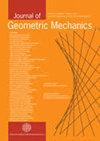Koopman wavefunctions and classical states in hybrid quantum–classical dynamics
IF 1
4区 数学
Q3 MATHEMATICS, APPLIED
引用次数: 12
Abstract
We deal with the reversible dynamics of coupled quantum and classical systems. Based on a recent proposal by the authors, we exploit the theory of hybrid quantum–classical wavefunctions to devise a closure model for the coupled dynamics in which both the quantum density matrix and the classical Liouville distribution retain their initial positive sign. In this way, the evolution allows identifying a classical and a quantum state in interaction at all times, thereby addressing a series of stringent consistency requirements. After combining Koopman's Hilbert-space method in classical mechanics with van Hove's unitary representations in prequantum theory, the closure model is made available by the variational structure underlying a suitable wavefunction factorization. Also, we use Poisson reduction by symmetry to show that the hybrid model possesses a noncanonical Poisson structure that does not seem to have appeared before. As an example, this structure is specialized to the case of quantum two-level systems.混合量子-经典动力学中的库普曼波函数和经典态
我们处理耦合量子系统和经典系统的可逆动力学。基于作者最近的一个建议,我们利用混合量子-经典波函数理论设计了一个耦合动力学的闭包模型,其中量子密度矩阵和经典Liouville分布都保留了它们的初始正号。通过这种方式,进化允许在任何时候识别交互作用中的经典态和量子态,从而解决一系列严格的一致性要求。将经典力学中的Koopman的Hilbert-space方法与前量子理论中的van Hove的酉表示相结合,通过适当的波函数分解的变分结构得到闭包模型。此外,我们使用对称泊松约简来表明混合模型具有以前似乎没有出现过的非规范泊松结构。作为一个例子,这种结构是专门用于量子二能级系统的。
本文章由计算机程序翻译,如有差异,请以英文原文为准。
求助全文
约1分钟内获得全文
求助全文
来源期刊

Journal of Geometric Mechanics
MATHEMATICS, APPLIED-PHYSICS, MATHEMATICAL
CiteScore
1.70
自引率
12.50%
发文量
23
审稿时长
>12 weeks
期刊介绍:
The Journal of Geometric Mechanics (JGM) aims to publish research articles devoted to geometric methods (in a broad sense) in mechanics and control theory, and intends to facilitate interaction between theory and applications. Advances in the following topics are welcomed by the journal:
1. Lagrangian and Hamiltonian mechanics
2. Symplectic and Poisson geometry and their applications to mechanics
3. Geometric and optimal control theory
4. Geometric and variational integration
5. Geometry of stochastic systems
6. Geometric methods in dynamical systems
7. Continuum mechanics
8. Classical field theory
9. Fluid mechanics
10. Infinite-dimensional dynamical systems
11. Quantum mechanics and quantum information theory
12. Applications in physics, technology, engineering and the biological sciences.
 求助内容:
求助内容: 应助结果提醒方式:
应助结果提醒方式:


